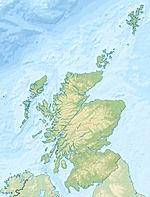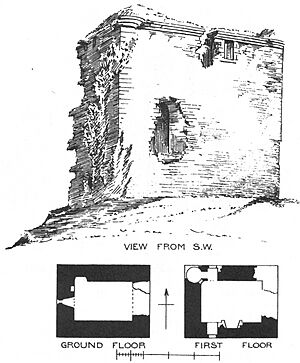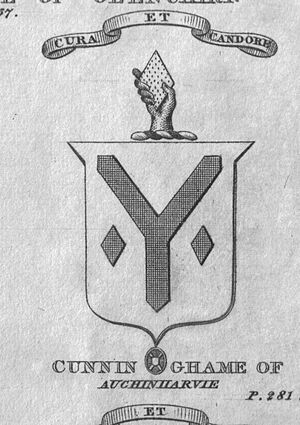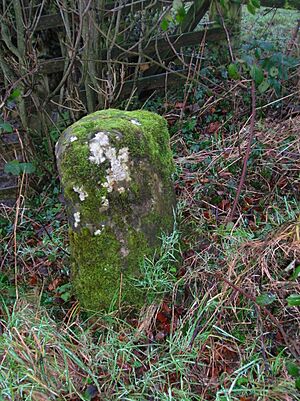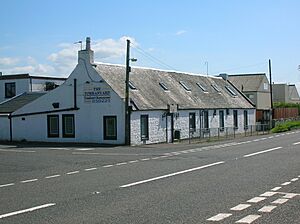Auchenharvie Castle facts for kids
Quick facts for kids Auchenharvie Castle |
|
|---|---|
| Torranyard, North Ayrshire, Scotland | |
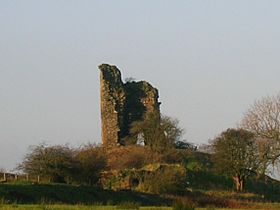
Auchenharvie Castle in 2007
|
|
| Coordinates | 55°39′54″N 4°36′16″W / 55.664972°N 4.604361°W |
| Type | Tower |
| Site information | |
| Owner | Alex Bicket Ltd |
| Controlled by | Cunningham Clan |
| Open to the public |
Private. Hazardous. |
| Condition | Ruined |
| Site history | |
| Built | 16th century |
| In use | Until 17th century |
| Materials | Whinstone |
Auchenharvie Castle is a castle that is now in ruins. It is located near Torranyard, on the A 736 road between Glasgow and Irvine. The castle is in North Ayrshire, Scotland.
Contents
History
The Castle's Story
Auchenharvie Castle stands on a strong, easy-to-defend spot at Auchenharvie Farm. The area around it has changed a lot because of quarrying (digging for stone). Over time, the castle's name has been spelled in many ways, like Achin-Hervy and Auchenhowy.
float: right; margin-left: 1em; margin-bottom: 0.5em; clear: right; The castle has been a ruin for a very long time. Maps from the early 1600s already show it as ruined. It was too small to be made into a bigger, more comfortable home.
The castle has special stone supports called corbels. These supports stick out less than usual. This design is similar to other castles like Law Castle and Barr Castle. Auchenharvie Castle is built from whinstone, which is a hard, dark rock. Its corners are made of freestone, a type of stone that can be cut easily.
Even though it has been a ruin since the 1770s, much of this typical tower castle remains. You can still see parts of its curved roof, a side tower, and fancy stone decorations. Some basic repair work has been done to keep it from falling apart more.
Interestingly, rare orchids grow on the castle mound. Long ago, around the 5th or 6th centuries, people cleared a lot of land here. This castle site was very important to early settlers because it stood out like an island above the wet, boggy areas.
Please note that Auchenharvie Castle is on private land and can be dangerous to visit. It is also the smallest of the castles near the "Three Towns" (Saltcoats, Ardrossan, and Stevenston).
The Cunninghames of Auchenharvie
The Cunninghame family owned Auchenharvie Castle for a long time. One family member, Edward Cunninghame, was killed in a fight with the Clan Montgomery in 1526.
The most famous owner was Dr. Robert Cunninghame. He became a Baronet of Nova Scotia in 1673. A Baronet is a special title, like a knight, that can be passed down. Dr. Cunninghame was also the doctor for King Charles II in Scotland. He was appointed after the King's crowning at Scone in 1651.
Dr. Cunninghame was with the King's army when they lost a battle in 1651. He was captured and held in the Tower of London until a ransom was paid. He was a very rich man. He bought back the land of Stevenston from the Earl of Eglinton in 1656.
Dr. Robert Cunninghame died in 1676. His son died just two years later. Because his daughter could not inherit the land, it went to her male cousin, Robert Cunninghame.
In 1678, Robert Cunynghame, who was an apothecary (like a pharmacist) in Edinburgh, inherited the lands of Auchenharvie. He also owned parts of Lambroughton and Chapeltoun. He married Anne Purves in 1669 and they had seventeen children! Despite his wealth, he later got into serious debt.
Another owner was Sir David Cunningham of Auchenharvie. He spent a lot of time away from the castle, working at court in England. In 1634, he planned to add more buildings, starting with a garden wall around the old tower. In 1628, he thought the castle was too small for his friends to stay. So, he asked his cousin to host his mother, so his friends could stay at his cousin's home instead.
By 1829, a map by Aitken showed that a Colonel Barns owned the castle.
Auchenharvie House
The Cunninghame family later built a new estate called Auchenharvie in Stevenston. This house is no longer standing, but its name lives on in Auchenharvie Academy, a local school.
A part of the old estate, Middleton, later belonged to the Hamiltons and then the Earls of Eglinton. Robert Reid Cunninghame was a well-known family member at the new site. He was very involved in coal mining in the Stevenston area.
Lesley Baillie, famous from the poem 'Bonnie Lesley', was a descendant of the Cunninghames of Auchenharvie.
The Toll Road
The old toll house near Auchenharvie Castle farm was taken down in the 1990s. A private house with the same name now stands there. A toll road was a road where you had to pay money to use it.
The old road junction is still there as farm tracks. A road used to go across the fields from here. It crossed the river by a shallow spot (a ford) below Megswell farm. This road went under the Montgreenan driveway, which had a very fancy bridge. But when the Lochlibo Road was built, this old route was no longer needed.
Torranyard
Template:Float left Torranyard is a small village at a crossroads on the 'Lochlibo Road' from Irvine to Glasgow. Its name has been spelled differently over the years, like 'Turing Yard' and 'Turnyard'.
On an 1860 map, Torranyard had a toll booth and an inn called 'Tour'. This inn was on the opposite side of the road from the current Torranyard Inn (as of 2007). The Montgreenan estate and hotel is close by. The site of the old Girgenti house and its remaining tower are also nearby on the Cunninghamhead road.
There were nicknames for inns in the area. The inn at Burnhouse was called the 'Trap 'Em Inn'. The one at Lugton was the 'Lug 'Em Inn'. The inn at Auchentiber was the 'Cleek 'Em Inn'. And the inn at Torranyard was known as the 'Turn 'Em Out'.
A miner named William Forgisal (or Fergushill) from Torranyard worked at the Doura Pit in the 1700s. He lost his leg in a mining accident, just like his father had. William's wife was very tough. When she saw him with his injury, she joked that the Forgisals would need their own small farm just to grow enough wood for crutches!
Today, the castle mound is full of beautiful wildflowers. However, anyone visiting should be careful. The castle is on a high spot with a steep, unfenced drop.
Images for kids
See Also
- Torranyard


